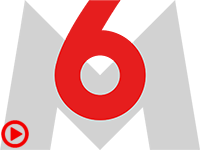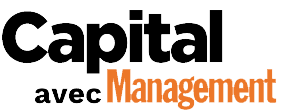Equipment
On this page you will find all the important information concerning the compulsory equipment, the recommended equipment, as well as advice to facilitate the storage of your bag. You will also find advice and tips from former runners.
In order to prepare your material as well as possible and not to forget anything, you will find below information concerning:
MANDATORY EQUIPMENT
First, you will find below the compulsory equipment for the race (per person):
- A WAA Ultra Bag 20L backpack or equivalent
- A packaging capacity of 1.5 liters of water (gourd, water bag, etc.)
- A sleeping bag
- A headlamp (which must be turned on after dark) + 1 complete set of spare batteries or battery
- 10 safety pins
- A lighter
- A whistle
- A metal blade knife
- A skin antiseptic
- A signaling mirror
- A survival blanket
- 8 soup cubes (2 per day) to help the rehydration
- A tube of sunscreen
- 100 euros in cash
- Passport or identity card (depending of the destination)
- The official MDS medical certificate completed by a doctor (form available 3 months before the race).
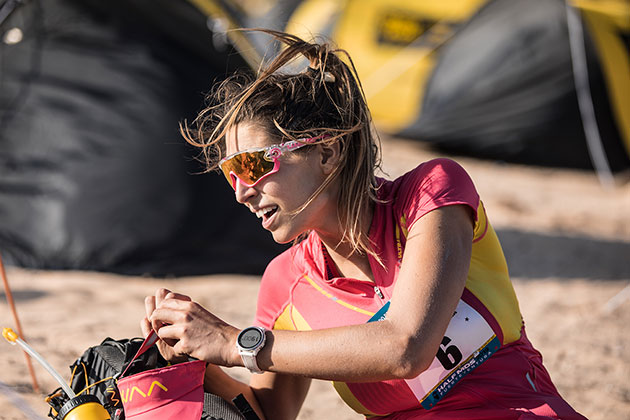
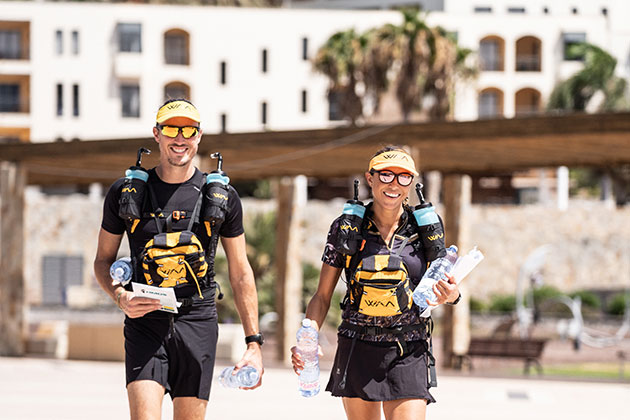
A race kit will be provided by the organization and given during the technical and medical checks, it will contain:
- A GPS geolocation tag
- The bibs
- a front bib (upper part of the chest
- a back bib (on the backpack)
- Chrono tag (small card used for timing to hang on the backpack)
- The road-book
The road book is the MDS runner's guide, in which you will find all the information concerning the adventure:
- A route map
- Details concerning the stages (program, map, terrain, etc.)
- The guide for using the GPS tag
- General information about your stay (excluding the race)
- Useful information
- The table of penalties
Throughout the duration of the event, the identification marks provided must be visible on each participant at the location indicated to avoid penalties.
You will evolve in the wilderness, in the middle of nowhere, literally. The course will be marked out approximately every 50m. If, however, you get off the right track, the GPS beacon with which you are equipped will alert the organization, allowing them to find you and bring you back to the course quickly.
RECOMMENDED MATERIAL
The sticks
Doing the MDS with sticks or without sticks, that is the question.
One thing is certain, if you want to take them for the race, you must train with them beforehand because it requires a minimum of experience and coordination.
The sticks will help you balance while running.
They will also be useful for going up and down, so you can lean on them. They will be particularly useful for people who plan to walk during the adventure.
Light sticks will allow you not to carry too much weight if you ever decide to put them in your bag during a moment of the race.
There are sticks in 3 strands and telescopic, the first being generally lighter but the telescopic more compact and practical, here again the ideal is to test the two and their arrangement to make the best choice.
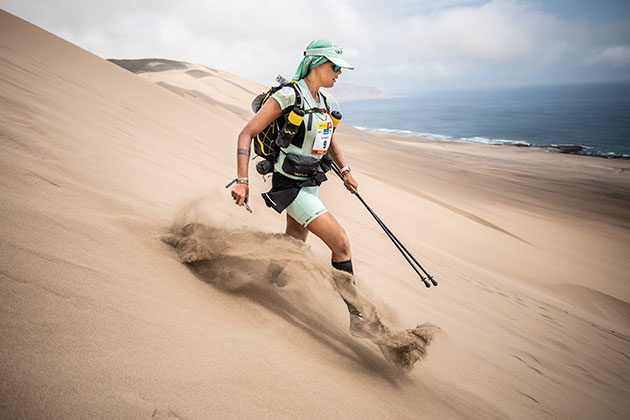
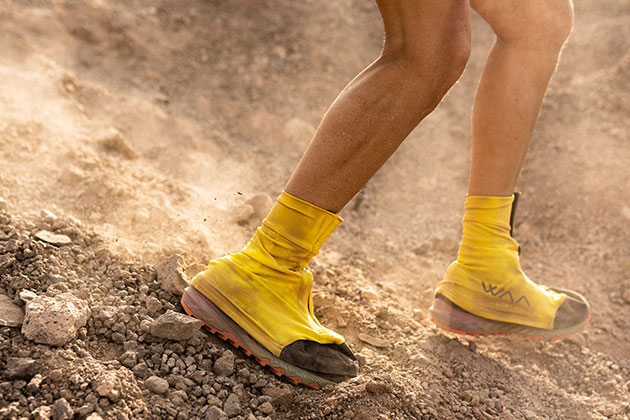
Shoes and gaiters
The use of gaiters is highly recommended. Indeed, these will allow you to prevent the sand from getting into your shoes and annoying you during the adventure.
To put gaiters on your shoes, you must have them affixed by a shoemaker, which can sometimes take up to 10 days, so it must be taken care of well before the race and not at the last minute.
Here you will find an example of gaiters used by a large majority of runners: WAA gaiters.
For shoes, it is recommended to use trail type shoes with a sole that grips. Some runners prefer to take a larger size than usual to avoid being squeezed if the feet swell with heat, or to be too cramped due to sand, bandage or blisters. Do not hesitate to try on your shoes before the race, in conditions that would be similar to those of the MDS, to find out which type of shoe suits you best.
Of course, you have to be able to get used to your shoes a minimum before the race, so avoid new models.
Advice from former runners on shoes for the MDS
(Please note, these tips are specific to each. Some tips may suit you, while others will not. It is important to try your shoes for the MDS beforehand)
- Trail shoes, all types of terrain, with good grip (large crampons), light, long distances, with good cushioning
- It is better to sew the gaiters on the shoes
- It is really important to test the shoes beforehand
- There is no particular shoe brand to choose


Dress code:
For the race, the majority of runners wear only one outfit to avoid being overweight in the backpack. It is nevertheless possible to take an extra top or a stocking, but keep in mind that you will have to carry it during the race.
Here are the qualities that your clothes will have to have so that you can live the experience in the best possible conditions:
- Light clothes
- Breathable clothing that dries quickly
- Comfortable and frictionless clothing
- The plus: practical clothes with pockets
The recommended clothes are:
- For the top, either:
- For the bottom, either:
- Motion Running Shorts or Run Free Shorts for men
- Motion Running Skirt for women
- For the head, a Saharan cap will allow you to cover your head and your neck to avoid getting hot and will protect your neck from the sun.
For the bivouac, you will need other clothes to be able to change when you return to the camp. The ideal is to opt for very light clothes (for the weight of the bag) which are comfortable to wear and which keep a little warm for evenings and mornings at the bivouac. Many competitors wear tights, a long-sleeved technical t-shirt and underwear. You can also take a pair of flip flops for the bivouac, or as some do, slippers!
Here are the products we recommend:
- A Wind Running Jacket for men or women (light and practical because it is compressible for easy storage in the bag) which can also be used for night racing.
- An Ultra Light T-shirt for men or women (light, very comfortable and does not take up space).
Obviously, the desert sun will not spare you if you forget your sunglasses, so remember to have them with you and to wear them during the race.
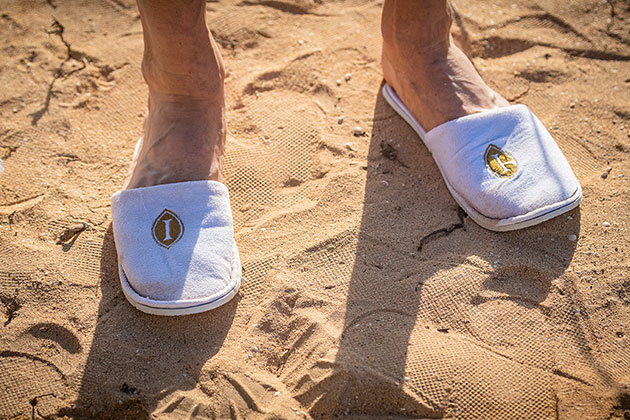
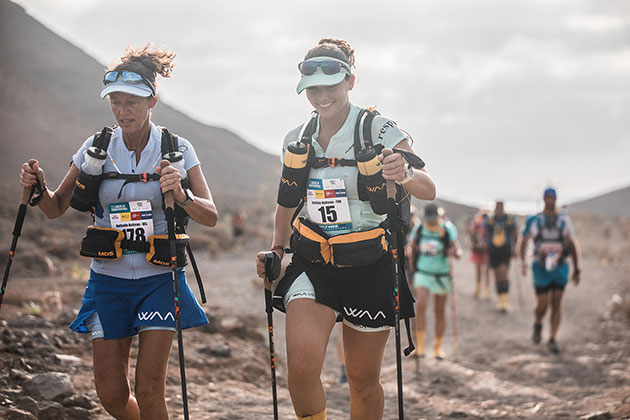
Advice from former runners on clothing for the MDS
(Please note, these tips are specific to each. Some tips may be suitable for you, while others are not. It is important to try your clothes for the MDS beforehand)
- Put a sleeve and a wet scarf under the cap
- Take technical, short and comfortable clothing
- Light & breathable clothes, which dry quickly
- You have to be comfortable in your clothes
- Bring clothes for the night
- Take a windbreaker
- Take spare underwear and socks
- Do not forget the gaiters
- A single outfit for running and for the bivouac may be enough depending on the needs of each
- Perfect fit to the body to prevent burns
- Prepare yourself with the outfit
- Take leggings for the evening
- Take clothes with many pockets to distribute the load
- Take very good technical clothing
Kitchen equipment:
- Regarding food equipment, you will need
- A pot: to heat your water and food
- A stove: which will serve as a support for placing your meal and heating it
- Fire pellets: the fuel to heat your meals
- Lighter: to light your pellets - there is a lot of wind in Fuerteventura so a storm type lighter could be useful
- Cutlery (fork, spoon…)
Gas stoves are strictly prohibited.
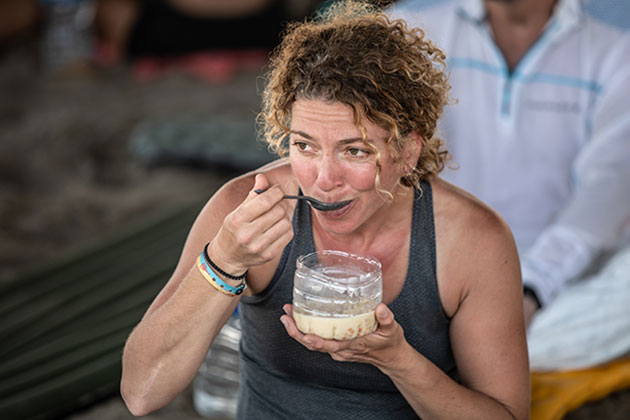
Advice from former runners on kitchen equipment for the MDS
(Please note, these tips are specific to each. Some tips may suit you, while others may not. It is important to try your kitchen equipment for the MDS beforehand)
- Take the lightest possible material
- Take a saucepan with a lid to avoid sand in the food and to heat up the meal faster (otherwise take aluminum foil)
- Esbit offers light and efficient equipment
- Try to find a “fork spoon”
- Take an aluminum or titanium saucepan or pot to heat the water
- Use a bottle of water cut in 2 as a bowl
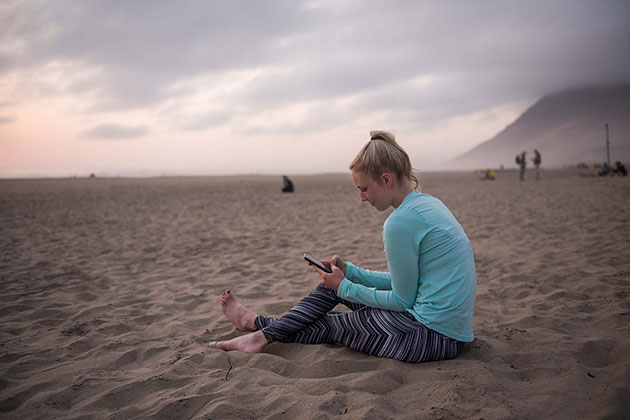
Mobile phone:
Depending on the destination, there may be more or less 4G network available on the route and the bivouac (there is no wifi on the bivouac). It is up to you to ensure that your telephone operator authorizes you to use your telephone abroad. On the other hand, there will be no electrical outlets to charge your devices, so if you wish, you can bring a small external or solar battery, but think that you will have to carry it during the whole event.
Telephones are therefore authorized, however, it is prohibited to telephone on the bivouac or on the course. If you want to make a phone call, you will have to move away from these places so as not to disturb anyone.
Advice from former runners on the equipment to take for the MDS
(Please note, these tips are specific to each. Some tips may suit you, while others may not. It is important to try your material for the MDS beforehand)
- 3rd bottle to wet your head
- A good pair of shoes (suitable for the terrain - sand & stones)
- The gaiters
- Sun protection lipstick
- Ticks
- NOK cream (be careful not to make the bag too heavy)
- Aspirin
- Mattress for a good night's sleep
- Warm clothes for the evening (leggings)
- Cap
- Sunglasses
- Wet hygiene wipes (in tablets) or compressed towels
- Good pair of socks (double wall)
- Flip-flops or slippers for the bivouac
- Mobile phone to take photos (+ battery)
- Stove
- Windbreakers
- Toilet paper
- Vaseline
- Esbit tablets to heat water
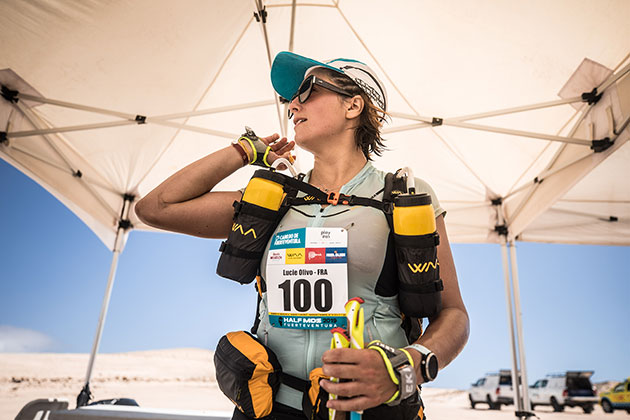

OUR ADVICE
For the night, the average temperature is around 10-14 ° C, it is therefore necessary to bring a comfort duvet around 10 °. Also choose a sleeping bag which does not take up too much space and which does not weigh heavy. You can also bring a mattress to sleep. It is not mandatory but is recommended to avoid difficult nights. You can, if you want to, bring a day cover and earplugs for more comfort.
Advice from former runners on the sleeping bag for the MDS
(Please note, these tips are specific to each person. Some tips may suit you, while others may not. It is important to try your sleeping bag for the MDS beforehand)
- It must be light, warm, compact and thin
- Be careful not to take something too hot for non-chilly people
- Practice upstream folding and unfolding the sleeping bag (for storage of the bag)
- Recovery is important, so do not neglect the material for sleep
- Try to take a light and thin small mattress (foam for example)
- You can combine a bag + a lining
- No need to take a too large sleeping bag
To organize yourself, plan on having a "health and well-being" sachet which will contain the skin antiseptic (compulsory), your medicines in case of treatment, spare safety pins.
We recommend that you keep your passport and cash in an airtight inner pocket. One of the elements that will take up a lot of space during the adventure will be the food package.
Make sure you pack all of your freeze-dried in one bag, which will be much more convenient to handle each day. You can put your bars and snacks for the stages in the front pockets of your bag in the morning for easy access at any time.
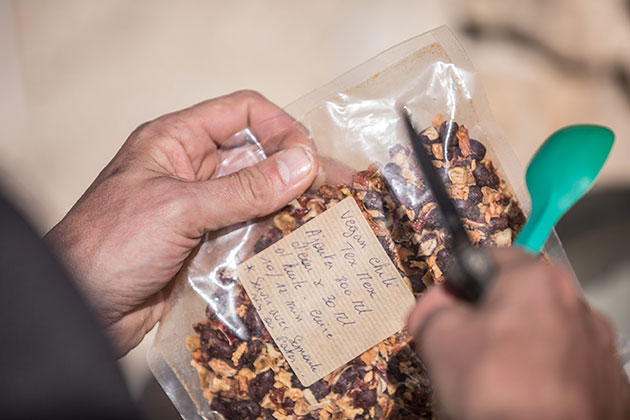

Hygiene
During the race, we will provide toilets, however, you will need to bring your own toilet paper because it is not provided. There will be no shower, so you will need to bring cleaning wipes if you want to wash (or "glove-wipes"). You can obviously bring a small soap, a small shampoo that you can use with your water rations to wash yourself or your clothes (especially during the rest day). As for the toothbrush, the little tip to save weight is to cut a part of the handle to keep only the brush, and take a mini tube of toothpaste.
You can also take a protective lip balm to prevent it from drying out in the wind and the sun.
All in all, take care not to take classic large products that would quickly increase the weight of the bag.
To travel
Of all the MDS participants who fly, the odds are that some suitcases get lost and don't arrive, making the start of the race difficult for those with their race gear inside.
Lost suitcases often take more than a day to be found and to arrive safely, which is why, we strongly recommend that you do not leave your racing gear in your checked baggage and therefore take as much as possible needed with you.
You should therefore take with you in the cabin: your shopping bag, your outfit, your shoes and all the equipment that is accepted in the cabin (be careful not to bring prohibited items). So, in case of a lost suitcase, you will have enough belongings to participate in the race.

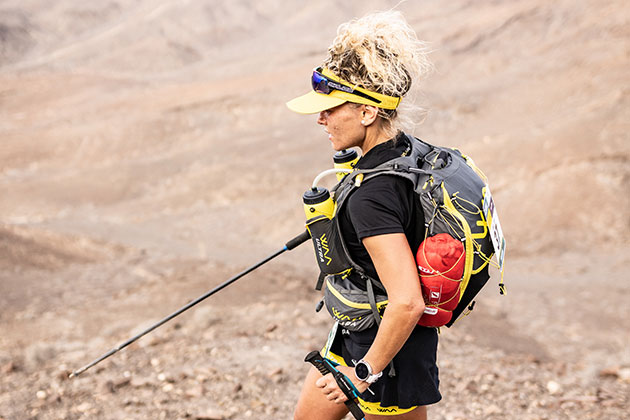
THE BACKPACK
You have to carry everything you need for four days, so you can’t take just any bag for the race. The Ultra Bag 20L is the recommended bag for the race, for the following reasons:
- It has been thought out and designed especially for this type of adventure
- It is worn and approved by hundreds of finishers
- It includes 2 750ml cans which are part of the compulsory equipment
- He has a whistle on the chest which is also part of the compulsory equipment
- It has a 270-degree opening allowing you to access all your equipment quickly and easily
- Its chest pockets give access to all the small equipment that you will need during the stages, which will save you from having to search in your bag during the race
Your bag will probably weight between 7 and 9 kg (without water), at the start, and two pounds less on your arrival once you have eaten all your food (make sure you stay within this weight scale).
It is better to be used to walking and running with this load. It is therefore important to plan to run at least 2 to 3 times with the bag loaded at around 3-4 kg in the 2 months before the race to be able to prepare for this. You shouldn't overdo it either, at the risk of hurting your back.
This will also allow you to adjust it (position of the equipment inside, tightening of the straps ...).
The preparation of the bag is a fundamental part of the pre-race. So that you can put everything you have planned in it, you must have the right technique! An improperly filled bag can cause back problems and loss of space.
Advice from former runners on the backpack for the MDS
(Please note, these tips are specific to each. Some tips may suit you, while others may not. It is important to try your backpack for thex MDS beforehand)
- Minimize unnecessary packaging
- It should not weigh more than 7-8 kg (not including water)
- Make one sachet of food per day
- Know your bag well so you don't have to search for equipment during the race
- Recondition freeze-dried dishes to gain weight
- Do all the storage tests at home
- Do not bring anything superfluous, take only the strict minimum
- Make a good weight distribution between the front and the back of the bag, as well as between the left side and the right side
- Have the necessary for the race in the front pack of the WAA bag
- Do not forget to take a waterproof bag
MDS in the press
Testimonies from former participants
Equip yourself for the MDS
WAA Ultra has been developing specialized products for MDS participants since 2009.
